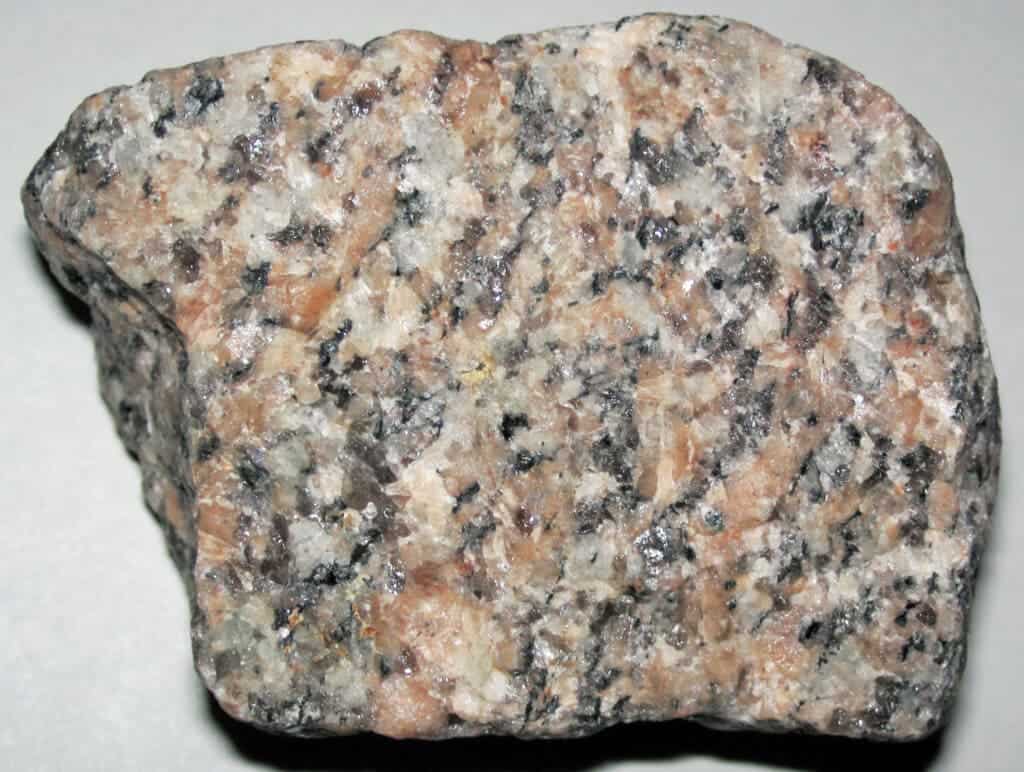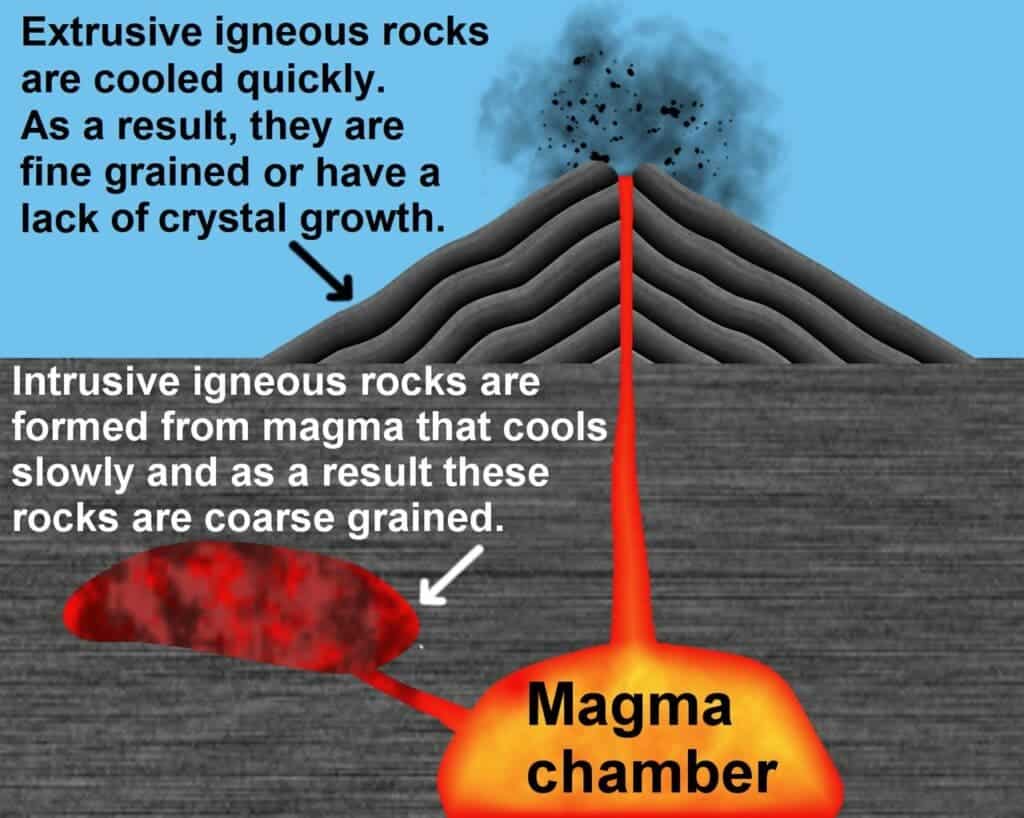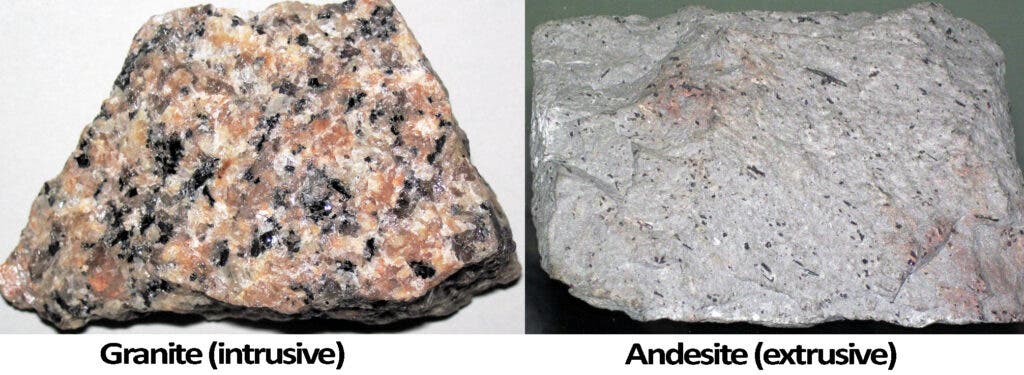There are three main types of rocks on Earth: igneous, metamorphic, and sedimentary. Out of these, igneous rocks are the “primary” rocks, the ones formed directly from the cooling of magma or lava. They are the driving force in the rock cycle and for anyone who’s curious about geology or about our planet, understanding the basics of igneous rocks is a must.

How igneous rocks form
The Earth’s crust, with everything we see on it, both on land and in the oceans, is by far the thinnest layer of the Earth. This solid, rocky exterior covers a mantle that is far thicker and hotter than the crust. This mantle moves very slowly, driving the movement of tectonic plates, and, sometimes, it also reaches past the crust and up to the surface.
When the magma from the mantle reaches the surface, it cools down. It can slowly move toward the surface, in which case it cools down slowly, crystallizing in the depths before reaching the surface. This type of igneous rock is called intrusive rock (or plutonic rock). This type of rock has large crystals — the slower the cooling, the larger the crystals.
When the lava comes out of a volcano, it reaches the surface quickly and forms extrusive rock (or volcanic rock). This type of rock is fine-grained and has small crystals, or is not even crystallized at all.

So, already, we can tackle a common misconception: igneous rocks and volcanic rocks are not synonymous. Volcanic rocks are, in fact, a subcategory of igneous rocks.
Different types of magma and lava have different chemistries. The same magma, if cooled quickly or slowly, will produce a rock with a similar chemistry but different grain (crystal) size. For instance, basalts and gabbros are formed from the same type of molten magma, but basalts are extrusive igneous rocks with fine-grained crystals, while gabbros are intrusive igneous rocks that cool slowly and have coarse-grained crystals.
Intrusive igneous rocks
Igneous rocks are sometimes called plutonic, for Pluto (or Hades), the god of the underworld — a fitting name, considering that many igneous rocks don’t even reach the surface.
Magma is typically found deep inside the Earth, under the crust. But sometimes, it can get close to the surface, or even reach the surface. But even when magma feeds volcanoes on the Earth’s surface, most of it remains trapped below. Even by coming a little bit closer to the surface, however, magma can start to cool down.
The Earth has a geothermal gradient: the lower you go, the hotter it gets (in general — there are exceptions). So if some magma is, say, 60 km deep, and gets raised to 30 km deep, its new environment will be cooler than the previous one. At specific temperatures, some crystals may start to emerge. Common igneous minerals, like olivine, feldspar, quartz, or pyroxenes, are formed at temperatures around 650 to 1200°C.
A good way to differentiate intrusive rocks from extrusive rocks is by looking at the crystal size: generally speaking, intrusive rocks have larger crystals that are visible to the naked eye. These large crystals take a long time to grow, which explains why they only form when they cool slowly. So if you see an igneous rock and you’re not sure whether it’s intrusive or extrusive, look at the crystal size. When the crystals are very large (several centimeters), the rock can be called a pegmatite.

Plutonic rocks are also classified on the basis of their mineral content. Specifically, the relative amounts of four types of minerals are used to define a rock: Quartz, Alkali feldspar, Plagioclase feldspar, and Felspathoid. These are not normally capitalized, but we’ve capitalized them here because together, they make the QAPF diagram — a diamond-shaped diagram that classifies igneous rocks based on their relative composition of these four minerals.
Quartz is incompatible with feldspathoid, so rocks can contain either one or the other. Then, igneous rocks generally contain feldspar, but the proportion of alkali and plagioclase feldspar can vary greatly. Based on this variation, a rock can be named. Notably, the same diagram is used for extrusive rocks, but remember that even though the mineral composition may be similar, intrusive and extrusive rocks have different textures.

Another way of looking at igneous rocks is by splitting them by silica content. Rocks can be felsic (over 65% silica), intermediary (55-65% silica), mafic (45-55% silica), or ultramafic (<45% silica). In practice, felsic rocks tend to be white and mafic rocks tend to be dark.
Igneous rock examples: intrusive rocks
- Granite — granites are essentially a large family of rocks that contain large amounts of quartz (up to 60%), as well as feldspar in varying amounts. In addition, they can also contain other minerals like amphiboles.
- Diorite — diorites are similar in texture to granites but they are mostly dominated by plagioclase feldspar, and only contain small amounts of quartz.
- Granodiorite — transition rocks between the above-mentioned rocks.
- Gabbro — a gabbro is the mafic equivalent of a diorite — rich in plagioclase, but much richer in pyroxenes, amphiboles, and olivine.

- Foidolite — a rare phaneritic intrusive igneous rock that consists of more than 60% light-colored feldspathoids.
- Ultramafic — this is more a description than an actual rock name (actual rock names would be peridotite and dunite). These rocks are not on the QAPF diagram.

Extrusive igneous rocks
Rocks in the depths of the Earth can cool down slowly — but extrusive rocks don’t have that luxury. They are brought to the surface through volcanoes and cool down quickly.
Interestingly enough, the chemistry of the lava also determines the type of the volcanic eruption. For instance, basic lavas (that are darker and tend to produce mafic rocks) are hotter, but their eruptions tend to be less violent — think slow, Hawaii-type eruptions. Meanwhile, acidic lavas (that are not as hot and as dark) tend to produce more explosive eruptions.
The rapid cooling of extrusive rocks can also produce vesicles, which result in a rock with high porosity. Pumice is a good example of this.

Eruptions can happen not only in air, but also under seawater, in which case there is little time for crystallizing. Here, the lava can form a natural glass or obsidian: non-crystallized extrusive rocks. This is called a glassy texture, in addition to the phaneritic and aphanitic textures we’ve already discussed. Another example of texture is the porphyritic texture, in which large crystals are embedded into a matrix of small crystals or uncrystallized mass.

Here too, geologists use the same type of diagram, classifying rocks based on their content of minerals (yes, geologists really love their diagrams).
Here too there are exceptions (the above-mentioned obsidian and pumice being examples).

Igneous rock examples: intrusive rocks
- basalt — by far the most common igneous rock, both on Earth and beyond (over 90% of all volcanic rocks on Earth are basalt). Formed by the rapid cooling of lavas relatively poor in silica and rich in iron and magnesium.
- Andesite — the phaneritic equivalent of the above-mentioned diorite, the andesites are often porphyritic rocks, with larger crystals surrounded by a greyish mass. They often contain both white (feldspar) crystals as well as darker crystals (such as pyroxene or biotite).
- Dacite — dacites are also often porphyritic, but they contain more quartz than andesites.
- Scoria — a rock formed from a pyroclastic eruption ejected from a volcano as a molten blob and cooled in the air. It has a lot of vesicles.
- Pumice — pumice is also highly vesicular rock formed from ejecta, but scoria is denser, and pumice is much lighter (even floats on water).
- Obsidian — a naturally occurring volcanic glass with minimal crystal growth. Despite being dark, obsidian is produced from felsic lava

Igneous rocks on other bodies
Out of all the rocks we’ve seen on other celestial bodies, igneous rocks are by far the most numerous. In fact, on places like Mars, Venus, and the Moon, igneous rocks make up almost the entire planetary geology. It seems that you need plate tectonics to truly make a lot of sedimentary or metamorphic rocks, and in the absence of plate tectonics, igneous rocks just dominate.
The moon, for instance, mostly consists of the same rock-forming minerals we see on Earth. Feldspar, olivine, and pyroxenes are all common on the moon. The lunar maria represents ancient flood basaltic eruptions — flows that are also seen on Mars (which has the largest volcanoes in the solar system). However, samples brought back by the Apollo 11 crew also showed a new mineral that had not been observed on Earth (a mineral called armalcolite).
The surface of Mars is primarily composed of basalts, though it’s noteworthy that the basalts on Mars seem to be more silica-rich than those on Earth, and a bit more similar to andesitic rocks. In 2012, the Curiosity rover analyzed the first Martian rock samples, finding that the Martian soil in the sample was similar to the “weathered basaltic soils” of Hawaiian volcanoes.
Ultimately, igneous rocks play an essential part in the geology on Earth and in every celestial body that has a geology. Understanding them is essential to anyone who’s at least curious about geology.


